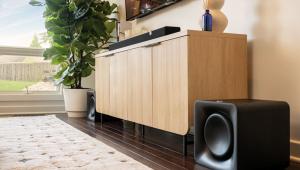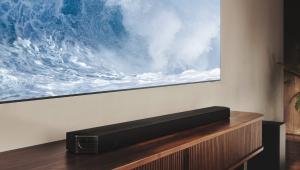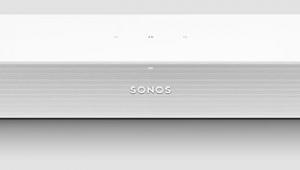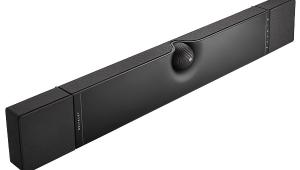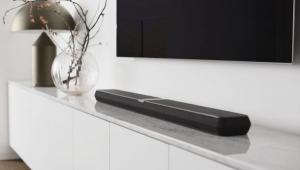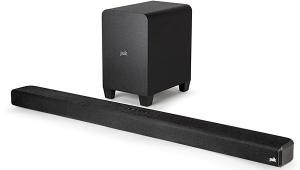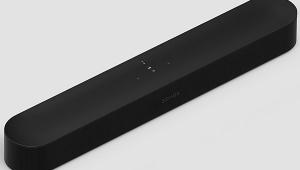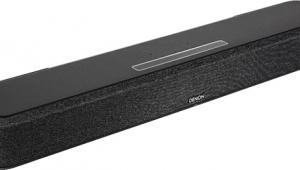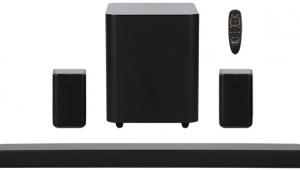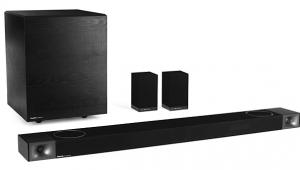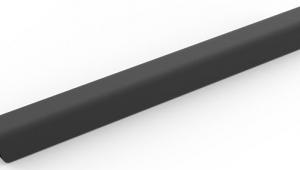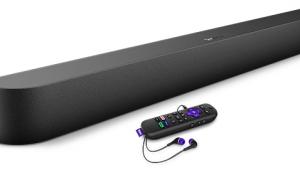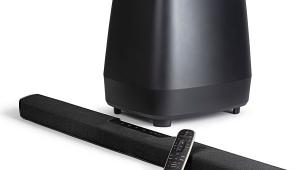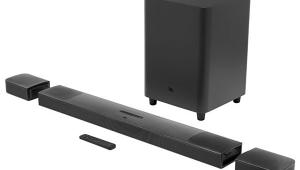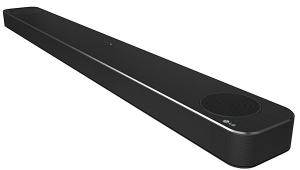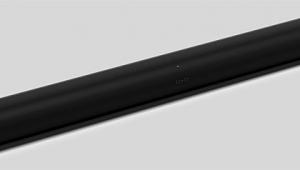Soundbars on a Budget Vizio SB3851-D0
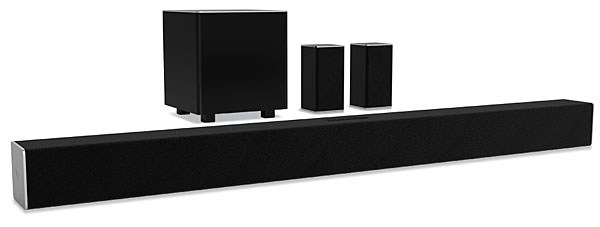
Vizio SB3851-D0
PRICE $300
AT A GLANCE
Plus
Full 5.1-channel system
with rear speakers
SmartCast app
HDMI passthrough
Plays loud
Minus
Port noise from tiny sub
Best with up-front sub placement
THE VERDICT
Along with decent sound quality and a loaded feature set, the rear speakers provided by Vizio’s SB3851-D0 soundbar system make it an easy recommendation.
Vizio’s first soundbars a few years back scored surprisingly well in a category not known for good sound. Part of that was Vizio’s inclusion of discrete rear surround speakers with some models. The satellites allow for true five-channel surround sound and discount the need for largely ineffective faux-surround processing that can mess with the sonics. This is a huge benefit—there’s absolutely no fair substitute for placing physical speakers at the back of the room when it comes to re-creating a surround soundfield. That said, Vizio’s solution, which involves running speaker cables to each satellite from the otherwise wireless powered subwoofer, encourages placement of the sub at the back of the room, where it may not work best when supplementing an up-front bar whose bass output starts dropping off at perhaps 100 Hz or higher and could leave localizable upper-bass elements of a soundtrack coming from behind the couch instead of the screen. But Vizio supplies long cables for the surrounds if you want to place the sub by the TV or on a side wall—like I did.
 The SB3851-D0 is 38 inches wide and features a stylish squared form factor that rests 3 inches tall. A string of LEDs runs up the left side to help track your volume and other adjustments. The bar hosts the front three channels of this 5.1-channel system, delivered by two full-range 2.75-inch drivers on each side for left and right, each accompanied by a 2x4-inch passive radiator, and a single 2.75-inch full-range for the center channel. The vinyl-wrapped MDF subwoofer module is both tiny at 9 inches tall and notably lightweight; it has a 5-inch down-firing driver and a port on the back along with its power switch and the outputs with RCA connectors used to drive the surround satellites. The 6-inch-tall sats offer a 2. 5-inch full-range in a solid-feeling plastic cabinet. Connections on the bar include HDMI in/out (with ARC), optical, coax, 3.5mm analog, and a USB port that accepts only WAV audio files for playback. Bluetooth wireless is also on board.
The SB3851-D0 is 38 inches wide and features a stylish squared form factor that rests 3 inches tall. A string of LEDs runs up the left side to help track your volume and other adjustments. The bar hosts the front three channels of this 5.1-channel system, delivered by two full-range 2.75-inch drivers on each side for left and right, each accompanied by a 2x4-inch passive radiator, and a single 2.75-inch full-range for the center channel. The vinyl-wrapped MDF subwoofer module is both tiny at 9 inches tall and notably lightweight; it has a 5-inch down-firing driver and a port on the back along with its power switch and the outputs with RCA connectors used to drive the surround satellites. The 6-inch-tall sats offer a 2. 5-inch full-range in a solid-feeling plastic cabinet. Connections on the bar include HDMI in/out (with ARC), optical, coax, 3.5mm analog, and a USB port that accepts only WAV audio files for playback. Bluetooth wireless is also on board.
The bar includes Vizio’s new SmartCast integration, which uses a Vizio iOS/Android app to Google Cast (via Wi-Fi) audio programming from your phone to the bar; you can also use any Google Cast audio-compliant app or the Chrome browser on a computer to do the same. (With Vizio video displays, SmartCast will hook you up with various movie and TV services as well. See our review of the Vizio M Series SmartCast UHDTV on page 56.) The Vizio app can also be used to group multiple SmartCast soundbars or wireless speakers for multiroom audio, and it’s great for accessing the bar’s many adjustments, including bass and treble, subwoofer level, center and rear surround levels, and more. The supplied remote, with its helpful LCD window to assist navigation, provides the same access.
Music
After listening to other soundbars, the first thing you notice with the SB3851-D0 is the big, spacious sound bubble it creates. After a little experimentation, I determined that music tracks were best rendered with the Music EQ setting (there’s a Movie setting as well) and with the rear surrounds turned up just enough to add depth and width to the front stage without calling much attention to themselves. Thus set, my test tracks engaged me with big voices imbued with bodies, and a more lifelike spread of instruments across the front than many soundbars can produce. Art Lande’s gentle solo piano on “Tenderly” from While She Sleeps (Blue Coast) produced big, round notes that, while not particularly three-dimensional, made their way out into the room.
Despite the benefits of more spacious staging, though, the Vizio’s sonics were marred by a slight lack of clarity and transparency compared with the other bars in this test, or even my day-to-day Sonos Play:One desktop monitors. Mayer’s bigger-than-life “Gravity” vocal, Diana Krall, and The Beatles’ opening harmonies on “Because” from the excellent Love remix all sounded a bit duller and more veiled than I’m used to hearing. For fairness, I should emphasize the subtlety here: I think less experienced or critical listeners (the target for this product) would miss the distinction and be wowed by the presence the Vizio delivered in the vocal range (though I found this fatiguing with some tracks) and its ability to play loud without obvious strain (I measured 91 dB SPL at my listening seat with steady-state pink noise).

However, not even those listeners could miss the huffing port noise from the sub module that initially made itself obvious on deep bass or drums, as on the “Gravity” opening, or later on the rumbling Mad Max soundtrack. Test tones showed that any steady bass around 50 Hz set the port fluttering. Fortunately, that effect was mitigated by keeping the subwoofer control below its default mid-point level. But it seemed like the subwoofer, while filling in appropriately just below the bar’s frequency range, wasn’t gracefully limited by DSP in the low bass.
Movies
For any of its weakness on music, the Vizio quickly availed itself on movies, where its discrete rear surrounds upped the engagement factor by a considerable margin against any traditional soundbar without back speakers. The precredits sequence that opens Max begins with a monologue that’s intended to come from above and behind and put you inside of Max Rockatansky’s head, an effect that was well rendered here and mostly or totally lost among the other bars I tested. In Hugo, when Monsignor Méilès’s sketches “escape” from their storage box and magically float and swirl around the room, they are accompanied by whooshing sounds and paper crackles and elements of the music score that match the onscreen action; the Vizio alone put me appropriately inside the scene. And in the many scenes in Hugo that take place inside the cavernous train station, the SB3851-D0 captured the appropriate acoustic of the open, reverberant space, while the traditional bars missed it completely or could barely approximate it. Feeding the Vizio a Dolby Digital 5.1 soundtrack of a college football game placed the crowd noise back behind me where it should be. The Vizio’s dynamic capabilities also lent an obvious benefit on movies and TV as well, though the deep bass elements remained noticeably absent, and I did find myself tweaking down the treble a bit to compensate.
Conclusion
Though not the most musically refined bar in this test, Vizio’s SB3851-D0, equipped with its rear speakers, punches out an impactful, engaging experience with television and movies on a short budget and brings something to the mix that the comparably priced competition does not.
- Log in or register to post comments

